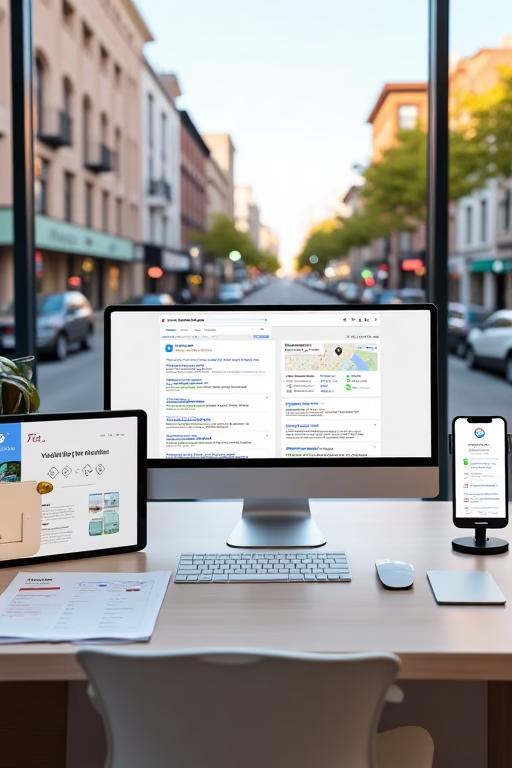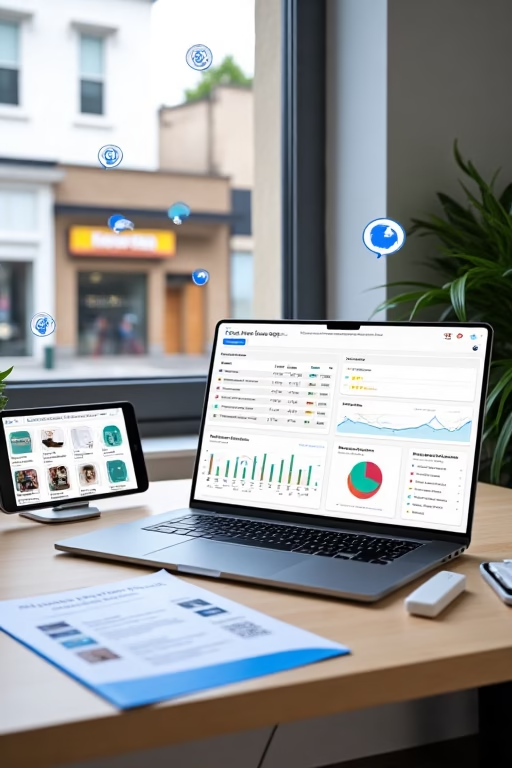Is Your Business Invisible on Google? Here’s the Fix
Is Your Business Invisible on Google? Here’s the Fix
Visibility Rescue Guide by Market Wiz AI
Table of Contents
- Introduction: Is Your Business Invisible on Google? Here’s the Fix
- 1. Diagnose the Visibility Gap
- 1.1 Check Search Console
- 1.2 Keyword Ranking Audit
- 1.3 Competitive Benchmarking
- 2. Google Business Profile Repair
- 2.1 Claim & Verify
- 2.2 Optimize Categories & Attributes
- 2.3 Add Photos & Posts
- 3. On-Page SEO Essentials
- 3.1 Title & Meta Optimization
- 3.2 Content Quality & Structure
- 3.3 Internal Linking
- 4. Technical SEO Audit
- 4.1 Crawlability & Indexing
- 4.2 Mobile Performance
- 4.3 Structured Data
- 5. Local SEO & Citations
- 5.1 NAP Consistency
- 5.2 High-Authority Directories
- 5.3 Review Management
- 6. Content Strategy Overhaul
- 6.1 Blog & Resource Pages
- 6.2 FAQ Sections
- 6.3 Multimedia & Engagement
- 7. Link Building & Outreach
- 8. Monitor & Refine
- 8.1 Set KPIs
- 8.2 Monthly Reporting
- 8.3 Ongoing Optimization
- 9. Conclusion & Action Plan
- 25 FAQs
- 25 Extra Keywords
Introduction: Is Your Business Invisible on Google? Here’s the Fix
Is Your Business Invisible on Google? Here’s the Fix that can rescue your online presence. If your site isn’t ranking, or your Google Business Profile is missing, you’re losing customers every day. This guide walks you through step‑by‑step diagnostics and targeted solutions to bring your business back into the spotlight.
1. Diagnose the Visibility Gap
1.1 Check Search Console
Review coverage reports for indexing errors and use performance reports to spot keyword drops. Identify pages with zero impressions.
1.2 Keyword Ranking Audit
Use tools like Ahrefs or SEMrush to see where you’ve slid in rankings. Benchmark against competitors to spot opportunity gaps.
1.3 Competitive Benchmarking
Analyze top rivals’ content, backlink profiles, and local citations. Understand what they’re doing that you’re missing.
2. Google Business Profile Repair
2.1 Claim & Verify
If you haven’t claimed your listing, do so immediately. Verify via postcard, call, or email to unlock optimization features.
2.2 Optimize Categories & Attributes
Select primary and secondary categories that match your core services. Fill out attributes like “Wheelchair accessible” or “Free Wi‑Fi.”
2.3 Add Photos & Posts
Upload high‑resolution images and publish weekly posts on offers, events, or blog excerpts to signal activity to Google.
3. On-Page SEO Essentials
3.1 Title & Meta Optimization
Place your focus keyword “Is Your Business Invisible on Google? Here’s the Fix” at the start of your title and first paragraph. Write compelling meta descriptions that include core terms.
3.2 Content Quality & Structure
Use clear headings (H2/H3), bullet lists, and concise paragraphs. Address user intent directly to improve dwell time and reduce bounce.
3.3 Internal Linking
Link to related service pages or blog posts to distribute authority and guide visitors deeper into your site.
4. Technical SEO Audit
4.1 Crawlability & Indexing
Ensure your robots.txt and sitemap.xml allow Googlebot to crawl all important pages. Fix 4xx/5xx errors promptly.
4.2 Mobile Performance
Run Google’s Mobile-Friendly Test and PageSpeed Insights. Aim for under 3‑second load times on mobile devices.
4.3 Structured Data
Implement Schema.org markup for LocalBusiness, FAQs, and Reviews to enhance rich snippets and visibility.
5. Local SEO & Citations
5.1 NAP Consistency
Audit your Name, Address, Phone across your site and all major directories. Use tools like Moz Local to automate cleanup.
5.2 High-Authority Directories
Ensure listings on Yelp, BBB, YellowPages, and niche sites. Remove duplicates and fill out complete profiles.
5.3 Review Management
Solicit reviews via email or SMS. Respond to feedback—positive and negative—to build trust and improve rankings.
6. Content Strategy Overhaul
6.1 Blog & Resource Pages
Create in‑depth articles and guides that answer customer questions. Use long‑tail variations of your focus keyword.
6.2 FAQ Sections
Add structured FAQ blocks on service pages to capture “People Also Ask” and featured snippet opportunities.
6.3 Multimedia & Engagement
Embed video explainers, infographics, and interactive tools to increase time on page and social shares.
7. Link Building & Outreach
Develop a targeted outreach plan to earn backlinks from local news sites, industry blogs, and partner organizations. Focus on relevance and domain authority.
8. Monitor & Refine
8.1 Set KPIs
Track impressions, clicks, click‑through rate, and conversions in Search Console and Analytics.
8.2 Monthly Reporting
Generate monthly visibility reports to compare progress and identify new issues.
8.3 Ongoing Optimization
Use A/B testing on titles and meta descriptions. Refresh content quarterly to maintain momentum.
9. Conclusion & Action Plan
Is Your Business Invisible on Google? Here’s the Fix: Diagnose quickly, optimize your profiles, audit your site, and execute a local and content strategy overhaul. Follow this roadmap, measure results, and reclaim your spot at the top of search.
25 Frequently Asked Questions
1. Why is my business not showing on Google?
Common causes include unverified Google Business Profile, poor on‑page SEO, or technical crawl errors.
2. How do I verify my Google Business Profile?
Claim your listing, then verify via postcard, phone call, or email to unlock full optimization tools.
3. What tools help diagnose visibility issues?
Google Search Console, Ahrefs, SEMrush, and Moz Local are essential for audits and monitoring.
4. How long does it take to see improvements?
Minor fixes can show results in weeks; comprehensive overhauls often take 3–6 months for full effect.
5. Can technical errors hide my site?
Yes—improper robots.txt rules, missing sitemaps, or server errors can block search engine access.
6. Is structured data important?
Structured data enables rich snippets, which can improve click‑through rates and visibility.
7. How do I maintain NAP consistency?
Use a single source of truth for your business details and sync updates across all listings.
8. What content should I update first?
Prioritize high‑traffic pages and those targeting your most valuable keywords.
9. How do I earn local backlinks?
Partner with local organizations, sponsor events, and contribute guest posts to community sites.
10. Should I focus on mobile speed?
Absolutely—mobile performance is a ranking factor and impacts user experience directly.
11. How often should I audit my site?
Perform a technical audit quarterly and monitor Search Console weekly for new issues.
12. Can reviews boost SEO?
Yes—positive reviews and high review velocity signal trust and relevance to Google.
13. What are rich snippets?
Enhanced search results featuring reviews, FAQs, and other structured data elements.
14. How do I choose target keywords?
Combine search volume, relevance, and difficulty metrics to select the best terms.
15. Is internal linking necessary?
Yes—it helps distribute page authority and improves site navigation and crawlability.
16. How do I fix duplicate content?
Use canonical tags, 301 redirects, or consolidate similar pages to prevent duplication issues.
17. What’s the role of social media?
Social signals indirectly support SEO by driving traffic, engagement, and brand mentions.
18. How do I measure local SEO success?
Track map-pack rankings, direction requests, calls, and form submissions from local pages.
19. Can I automate listings?
Yes—tools like Market Wiz AI can automate Google Business posts and citation submissions.
20. How do I handle negative reviews?
Respond promptly, offer resolutions publicly, and take sensitive details offline to resolve disputes.
21. Should I use PPC alongside SEO?
PPC can fill visibility gaps while your SEO efforts gain traction.
22. How do I optimize meta descriptions?
Include target keywords and a clear call to action within 150–160 characters.
23. What is crawl budget?
The number of pages Googlebot crawls on your site—optimize by fixing errors and consolidating low-value pages.
24. How do I stay ahead of algorithm changes?
Follow SEO news, adapt best practices, and prioritize user experience and content quality.
25. Where can I learn more?
Visit Market Wiz AI’s blog and resource center for in‑depth articles, webinars, and case studies.
25 Extra Keywords
- Is Your Business Invisible on Google
- fix Google invisibility
- recover search visibility
- Google ranking repair
- search console audit
- on‑page SEO checklist
- technical SEO audit
- mobile performance SEO
- structured data localbusiness
- NAP consistency tool
- local citation cleanup
- Google Business optimization
- blog content strategy
- FAQ schema SEO
- rich snippet implementation
- backlink outreach local
- performance monitoring SEO
- monthly SEO reporting
- PPC and SEO integration
- crawl budget management
- duplicate content fixes
- voice search optimization
- user engagement signals
- SEO algorithm updates
- site speed optimization
Is Your Business Invisible on Google? Here’s the Fix Read More »








